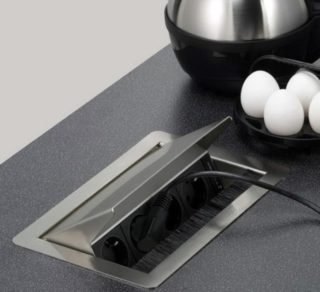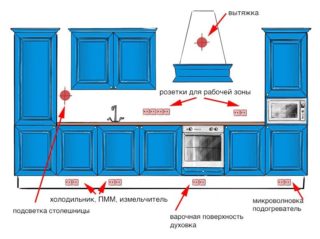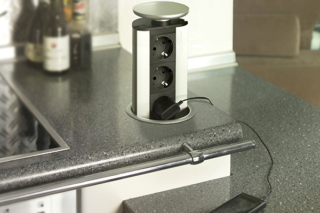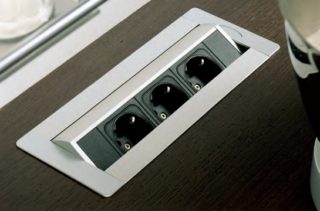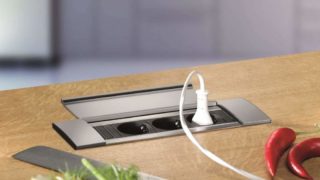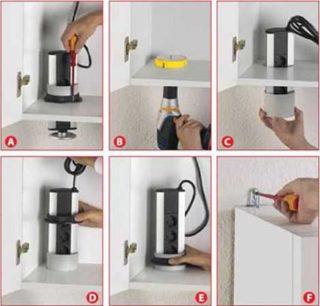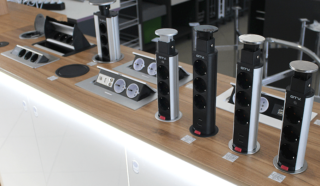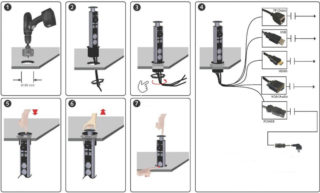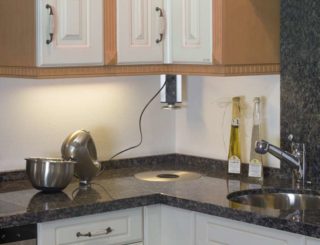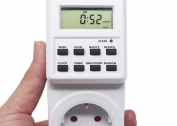Household appliances, which guarantee comfort in the kitchen and in the office, require connection to a power supply network. Numerous overhead type sockets will not be a highlight in the designer interior, regardless of the purpose of the room. The best solution in this situation will be a retractable outlet in the countertop. These devices are convenient to use, save space in the room and go well with any interior.
Location of outlets in the kitchen
Sockets in kitchens are recommended to be installed in 3 tiers:
- Upper - for hoods and lighting hanging cabinets.
- Central - located 10-15 cm above the countertops. Small household appliances are connected here: kettle, mixer, blender and others.
- The lower one is the power supply for the most powerful built-in equipment, which is constantly on the network: dishwasher, oven, refrigerator, etc.
It is recommended to connect built-in appliances with high load through RCD. There must be grounding.
Before installing hidden sockets for the kitchen in the countertop, you need to calculate their required number. For this, it is necessary to be guided by several basic calculation rules:
- The number of outlets should be 25% more than the number of electrical appliances in the kitchen. Thus, a reserve will be made for connecting additional devices: a kitchen vacuum cleaner or a fan. Example - for 8 pieces of equipment you will need to install 10 outlets.
- The wiring power is calculated in accordance with the total power indicator of all electrical engineering. This is necessary so that there is a double reserve for powering devices in the wiring. Sockets are divided into 2 types: 16 A - load up to 2.2 kW; 10 A - load no more than 3.5 kW. Do not supply more power to the outlet than its rated load;
- Devices with a high power indicator, for example, an electric stove or a boiler, must be connected via circuit breakers to a separate power line.
Retractable sockets are extremely convenient for use in the kitchen. This is especially noticeable when using those devices that do not require a permanent connection to the network.
Types and features of retractable sockets
Built-in sockets in the countertop - a block of 2 or more sockets, mounted in a metal or plastic case, which is equipped with a retractable mechanism. The device is easily pulled out of the countertop and easily immersed in it when pressed. A device of this type is a kind of surge protector, but it does not have bundles of wiring that do not look so aesthetically pleasing. The modern market offers users several varieties of pull-out type devices.
Vertical extendable tabletop outlet
This type of outlet is most often used. At the same time, their design is not the most practical and durable, since the “tower” towering above the countertop can be accidentally hit and easily damaged. In addition, the retractable vertical unit is subject to loosening, because when you insert the plug you need to make some effort.
Horizontal pull-out socket
It differs from other sliding devices in the horizontal placement of the outlet block and the height indicator of the extendable part.This design has high strength and is also more convenient in operation. Horizontal blocks also have a significant minus - a problematic connection of equipment with a side type of forks.
Retractable Swivel Outlet Block
Swivel-type built-in sockets are the most versatile of any retractable designs. They are ideal for arranging kitchen worktops, therefore they are very reliable and demonstrate a high level of ergonomics. Rotary blocks are tightly fixed in the plane and withstand frequent insertion / removal of forks, which means they are durable.
Unlike traditional pull-out units, this design is equipped with a swivel mechanism. It is triggered by pressing a finger on a specific area of the front cover. After opening the sockets, the device is fixed at an angle of 45 degrees.
The rotary block of sockets has some design flaws - locking and movable mechanisms that fail over time. Also, it is problematic to connect side-type plugs in them.
According to the type of installation, the rotary blocks are divided into 2 types:
- mortise - are installed directly in the plane of the countertop;
- angular - mounted in 90-degree angles (wall joints, wall / hanging cabinet combination).
Hidden sockets
The secret block of sockets is considered the most reliable and durable, since it is devoid of movable mechanisms. In fact, this is a classic extension cord that is recessed into the furniture body or the plane of the countertops. Such devices are unable to change their position. The block is protected from dust and moisture by a decorative cover. To connect electrical equipment, the cover must be raised up or moved to the side. This is the only minus of hidden devices - a place on the work surface is hiding from the cover.
Classification of countertop units
Sockets built into the table - a stylish solution for kitchen and office rooms. They can be mounted both in the plane of the countertops, and in cabinets or tables. Such blocks are an excellent alternative to standard extension cords, demonstrate higher versatility and comfort of use. Conventional extension cords are not always appropriate, especially in rooms such as conference rooms or designer kitchens.
By design type retractable sockets are:
- horizontal
- vertical
- hidden.
Horizontal type blocks can have from 1 to 5 power connectors. In addition to traditional plugs, they can be equipped with USB, HDMI and Ethernet ports for connecting Internet access.
By the method of access to outlets, the blocks are divided into retractable and rotary.
Some models of outlet blocks are equipped with a function of rotation of 180 or 360 degrees. Most of them have a backlight for ease of work in the dark and the formation of an appropriate style.
Swivel devices are highly reliable. In fact, they have no drawbacks, with the exception of one factor - the inability to interact with side types of forks.
Retractable sockets can be placed:
- In hanging cabinets.
- In the plane of tables / countertops.
- In the corner connection between the wall and the countertop.
One of the main characteristics of a mortise socket is the protection degree IP44 (resistance to dust and moisture).
Features of the device retractable structures
Retractable type power sockets make it possible to save space, as they eliminate the need to lay a separate power line for mounting additional network points.
The main features of such devices:
- the number of integrated connectors is from 1 to 5, all of them are grounded;
- cable length varies between 3-5 meters, depending on the model of the device;
- it is possible to connect the unit to the general power supply using a stationary plug or through electrical terminal blocks.
The principle of operation of the drawers is quite simple. In a static state, the structure is completely hidden in a cabinet or countertop. To connect any electrical appliance, you just need to click on the decorative cover, after which it will begin to extend, freeing up access to outlets. There are models that independently lift completely or extend only a couple of centimeters. They need to be pulled up by hand.
To hide the outlet blocks, you just need to push them on top and lower them into the countertop until they click.
Advantages and disadvantages
Retractable socket units are becoming more and more popular in modern interiors, as they have a whole range of undeniable advantages:
- High versatility.
- Do not take up space on the work surface.
- Suitable for connecting small kitchen electrical equipment that is not used constantly.
- On the market there are models with protection against moisture and dust. There are also devices with child protection.
- The perfect combination with any interior style.
- Possibility to choose between vertical and horizontal blocks.
- The presence of additional connectors, for example, USB or HDMI.
- Possibility of mounting in any surface - table / countertop.
In addition to the mass of advantages of the device have several disadvantages:
- Fairly high cost.
- When mounted in a hanging cabinet, its internal volume is hidden.
- Inability to install on sections of the countertop, where there are drawers under it.
- Vertical type blocks can easily be damaged due to their height indicators.
All the drawbacks of retractable sockets are offset by their versatility. The non-working block is invisible to the naked eye, its shape resembles a regular decorative ring / rectangle on the table surface.
Features of choice
When choosing a retractable type socket unit, you need to be guided by the price / quality ratio, and also pay attention to such factors:
- The required number of network connectors and the presence of additional ports for USB-devices, audio equipment and others.
- Unit specific power - an indicator of the total power of all electrical equipment should not exceed it.
- The ability of the socket unit to withstand voltage surges (filter function).
- The quality of materials for the manufacture of outlets. Cheap plastic can not withstand frequent connections / shutdowns. Such devices have a small service life.
- The presence of protection degree IP44. Prevents dust and moisture from entering the unit. This is especially important when choosing sockets for kitchen facilities.
Many users, when choosing outlet drawers, try to save on buying, giving preference to Chinese brands. There is nothing wrong with the purchase of a truly branded device. The main thing is not to buy copies of well-known manufacturers who sell at a low price, allegedly for stocks. Such blocks, in addition to low durability, are also dangerous: their plastic cracks when exposed to temperature and moisture, which can lead to a short circuit.
Installation Rules
When installing retractable sockets, it is necessary to adhere to several basic rules.
It is strictly forbidden to install blocks near the stove and near the sink. Short circuits can be caused by moisture and elevated temperatures. Sockets must be installed at least 60 cm from the sink and stove.
The process of installing hidden sockets
Installation of retractable outlet blocks is not complicated, home craftsmen will do it on their own without difficulty.
Algorithm of actions:
- Disconnect the room.
- Mark the installation location of the unit.
- Using a crown or a jigsaw, make a hole (diameter 65 mm) for mounting sockets in a table, cabinet or tabletop.
- Secure the device with the fasteners that come with the kit.
- Connect the unit to the network.
If at home there are no necessary tools, it is better to seek the help of specialists.
Selection of device location
Retractable type sockets are best installed in such places:
- In the working areas of countertops and tables where food is cooked. The best option here is to install the unit on 4-5 network connectors.
- In eating areas and dining rooms.
- In the recreation areas of the whole family. Here, the most rational will be the installation of outlet blocks with combined connectors, with the presence of USB and HDMI. This will allow you to connect phones and laptops to the network and the Internet.
The placement of each drawer must be thought out in advance. This will save owners from situations when one block is not in demand, but the other is overloaded.
